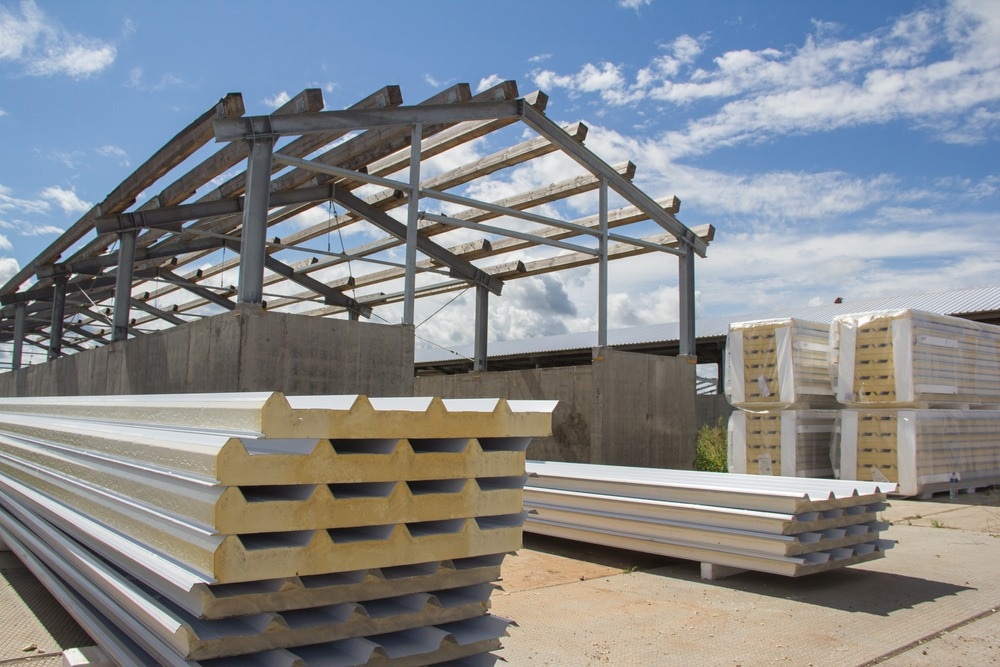The construction sector accounts for a significant proportion of carbon emissions, with concrete use alone accounting for around 8 % of total global greenhouse gas emissions.

Image Credit: Myfotoprom/ShutterStock.com
Added to this environmental problem is a growing and underrecognized sustainability crisis: the world is starting to run out of the sand used to produce concrete for buildings. The construction industry urgently needs more sustainable, eco-friendly alternatives. This article will explore how certain actors in the sector are leading the revolution in eco-friendly concrete.
The Problem With Concrete
Rapid population growth and urbanization in the 20th and 21st centuries have led to an unprecedented demand for building materials for domestic and commercial structures and infrastructure. While the modern era has undoubtedly brought vast benefits to the quality of life for billions of people, the environmental damage due to human activity has become strikingly apparent.
Concrete is the most commonly applied construction material in the world due to its relatively cheap production costs, abundant resources, and favorable physiochemical properties. However, while it has figuratively built the modern world, concrete and cement production has a vast ecological cost.
The manufacture of this critical building material accounts for around 8 % of total global carbon emissions. Worldwide consumption of concrete has reached approximately 30 billion tonnes yearly, which is more than three times the amount consumed just four decades ago. Demand for this material is outpacing that of steel and wood, two other common building materials.
The most carbon-intensive part of the concrete manufacturing process is making the cement. Fossil fuels are used to heat clay and limestone to over 1.400 °C, with roughly 600 tonnes of CO2 produced per tonne of cement. Add to this the vast consumption of resources, which is causing the growing depletion of irreplaceable natural materials such as sand, and it is evident that alternatives are needed.
Concrete and cement are not disappearing anytime soon. With the growing demand for climate-resilient architecture and structures to house an expanding world population, the concrete industry must be rapidly decarbonized to meet the UN’s sustainability goals.
What Alternatives Are There?
One way to promote a more sustainable and eco-friendly concrete industry is to utilize emerging green technologies. Phasing out fossil fuels in favor of renewable energy will go a long way toward achieving the sector’s goals. Embracing green technologies, such as electric arc furnaces, will help to reduce the need for carbon-intensive coke during cement production.
Another alternative is to develop more environmentally friendly materials that possess comparable physicochemical properties and performance to traditional concrete. In recent years, several notable innovative projects that contribute to a greener future for the concrete and construction industries have emerged. Some of these are listed below.
ETH Zurich: Low-Carbon Cement
The advent of low-carbon cement would significantly reduce the environmental impact of the concrete industry. Researchers from ETH Zurich, working with EPFL on the Limestone Calcined Clay Cements project, are setting a benchmark in green cement manufacture.
The benefits of this project are an innovative low-carbon cement that reduces CO2 emissions by around 40 %. The formulation uses only 50 % clinker, which typically makes up 95 % of conventional cement, along with a blend of limestone and calcined clay. Franco Zunino of ETH Zurich aims to take this even further by reducing clinker content and decreasing the cement ratio in ultra-green concrete.
Mimicrete: Self-Healing Concrete
While concrete has sufficient strength and other properties that make it an ideal building material, it becomes prone to degradation as it ages and copes with everyday stresses. One way to circumvent this issue is to imbue it with self-healing properties, extending its useful life and, by extension, that of structures built using it.
Mimicrete is a UK-based startup developing the next generation of self-healing concretes. The company’s proprietary material incorporates a biomimetic vascular network containing a healing agent to repair damage to the material. This network is analogous to the human circulatory system.
The healing agent works like clotting agents in human blood, healing the structure before catastrophic failure occurs. Mimicrete is being supported by £450,000 in funding from the UK Government’s Innovate UK initiative.
Mycocrete: An Innovative Mushroom-Based Concrete
Researchers from the UK and Belgium have developed an innovative concrete-like building material using mycelium paste. Injected into a formwork, a tough, durable, and adaptable material is produced that can be used in construction. This material is significantly more carbon-neutral than traditional concrete.
The Future
Numerous challenges face the concrete industry. Several companies and research projects are providing innovative solutions and alternatives to traditional cement and concrete.
To meet its sustainability goals and commitments to reduce carbon emissions in line with international agreements, the concrete industry must embrace emerging technologies and alternative materials—several companies have already stepped up and developed new environmentally friendly options to help realize these goals.
More from AZoBuild: How and Why Do We Recycle Concrete?
References and Further Reading
Kaiser. R., et al. (2023) BioKnit: development of mycelium paste for use with permanent textile formwork. Front Bioeng. Biotechnol. doi.org/10.3389/fbioe.2023.1229693.
Zunino, F. (2023) A two-fold strategy towards low-carbon concrete. RILEM technical letters. doi.org/10.21809/rilemtechlett.2023.179.
Scialom, M. (2022) Mimicrete sets up first commercial pilot for self-healing concrete. [Online] Cambridge Independent. Available at: https://www.cambridgeindependent.co.uk/business/mimicrete-sets-up-first-commercial-pilot-for-self-healing-co-9262828/.
Disclaimer: The views expressed here are those of the author expressed in their private capacity and do not necessarily represent the views of AZoM.com Limited T/A AZoNetwork the owner and operator of this website. This disclaimer forms part of the Terms and conditions of use of this website.